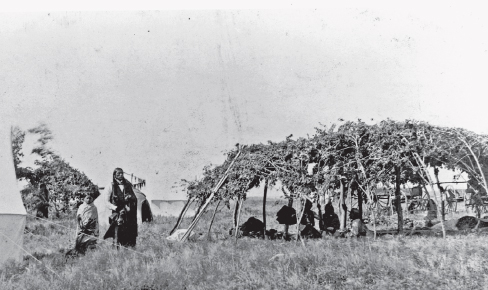
Cynthia Ann Parker, the daughter of white settlers, was the mother of Quanah Parker. She was known as Naduah.

Cynthia Ann Parker, the daughter of white settlers, was the mother of Quanah Parker. She was known as Naduah.
In 1834, the Parker family moved to Texas from Illinois. They settled on the bottomlands of the Brazos River. There they built a log stockade. Other frontier families joined them. These thirty or so pioneers made up the westernmost white settlement in Texas.
On May 19, 1836, many of the men had left Parker’s “fort” to work in the fields. Without warning, a hundred mounted warriors appeared outside the wall. Most of them were Comanche. One waved a soiled white flag. John Parker, leader of the settlers, sent his son Benjamin to talk with them. The band asked for beef to eat. When Benjamin refused, they killed him with lances. The horsemen dashed into the fort. They killed the adults, but Lucy Parker and her four small children slipped away. They headed for the river. Warriors briefly captured all five, but a man from the fort attacked the warriors. He forced the warriors to drop Lucy and two of the children. The warriors rode off with Cynthia Ann Parker, aged nine, and John Parker, aged six.
The war party rode their horses hard until midnight. At last, they stopped to make camp. Then they held a victory dance. The raid had been a triumph. No one had been killed or wounded. The captives were proof of their success. At dawn the dance broke up. The Comanche took the Parker children west. Cynthia and John survived the shock of capture. The Comanche adopted them into the tribe. Soon the children spoke the language and dressed like other Comanche.
Cynthia Ann Parker took the Comanche name Naduah. Once an army officer saw her at a council. She refused to speak in English. There was no sign that she was unhappy. She seemed to remember little of her early life. Around 1845, she married the warrior Peta Nokona. The couple had three children. Quanah, the oldest, was born around 1847.1 His name meant Fragrant. Quanah’s brother, Pecos (Peanut), was two years younger. His sister, Topsannah (Flower), arrived a few years later.
The sun on the Plains tanned Naduah’s skin. Soon, except for her blue eyes, she looked like other Comanche women. Quanah’s mother carried out the many tasks of a wife. She made the family’s clothing, bedding, tools, and tipi cover. When the band moved, she packed and unpacked all their belongings. Often she left the camp to gather wild fruit and other plants. Fruit came from the prickly pear cactus and persimmon and plum trees. Other trees provided acorns and piñon and hickory nuts.
Naduah spent much time preparing their meals. The family diet included dried meat, game, fruits, vegetables, and herbs. Quanah’s father hunted, killed, and butchered the game. Buffalo meat was the most common. The band also ate deer, antelope, and elk. Naduah stewed the meat in metal pots. She flavored it with wild onions and roots. Whenever he was hungry, Quanah could dip into the rich broth and pick out a tasty chunk.
Naduah made Quanah’s clothes from buckskin. He wore a loose-fitting shirt, leggings, and moccasins. A breechcloth was tucked into a belt in front and back. In cold or wet weather, Quanah slept in the family tipi. Ten to twenty buffalo hides made up the tipi’s cover. The hides rested on a framework of four large and a dozen smaller poles. During hot months, Quanah slept under a brush shelter, which was open to cooling breezes.
For Quanah, growing up was a time of waiting and training. He soon would become a Comanche warrior.

Chief Quanah Parker’s camp in 1893. During the hot months, the Comanche made shelters of brush and small trees for shade on the Staked Plains.